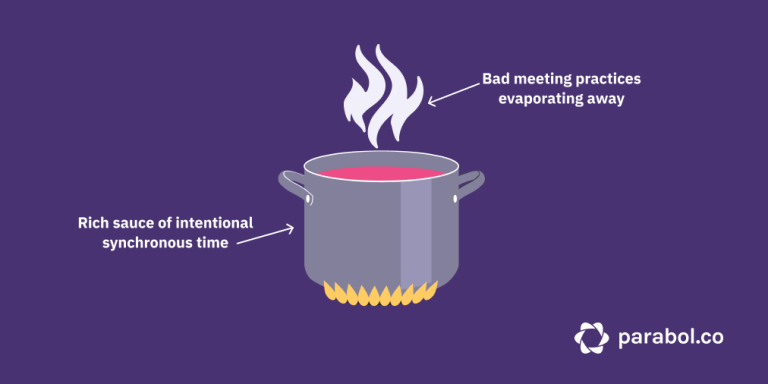How to Facilitate Inclusive Meetings for Introverts
Introverts are estimated to make up somewhere between 25-50% of the population. And while it’s always tempting to think in binaries, introversion and extroversion is a sliding scale.
Nobody is 100% introverted and 100% extroverted. We’re all ambiverts, with introverted and extroverted tendencies.

But if people on the introverted side of the scale make up almost 50% of the population, that means there are likely a fair few on your own team.
Much has been written about how hard it can be for introverts to get their voice heard in meetings.
In this article, we’re looking at what practical things meeting facilitators can do to make meetings more introvert-friendly.
In this article we cover:
What does it mean to be an introvert?
The terms introversion and extroversion were introduced by Carl Jung in 1921 and formed the basis of the famous (or infamous) Myers-Briggs type indicator, which claims to determine whether someone has dominant introvert or extrovert qualities (INTJ over here ).
The American Psychological Association defines introverts as having:
Orientation toward the internal private world of one’s self and one’s inner thoughts and feelings, rather than toward the outer world of people and things […] Introverts are relatively more withdrawn, retiring, reserved, quiet, and deliberate; they may tend to mute or guard expression of positive affect, adopt more skeptical views or positions, and prefer to work independently.
Susain Cain, an American psychologist and author of the book Quiet: The Power of Introverts in a World That Can’t Stop Talking, says that introversion and extroversion boils down to how much stimulation someone can handle.
Introverts are stimulated much more easily than extroverts and can reach a sort of cognitive overload much more quickly.
That’s why they tend to prefer calmer, low stimulation environments and gravitate towards jobs that give them more opportunities for deep work.
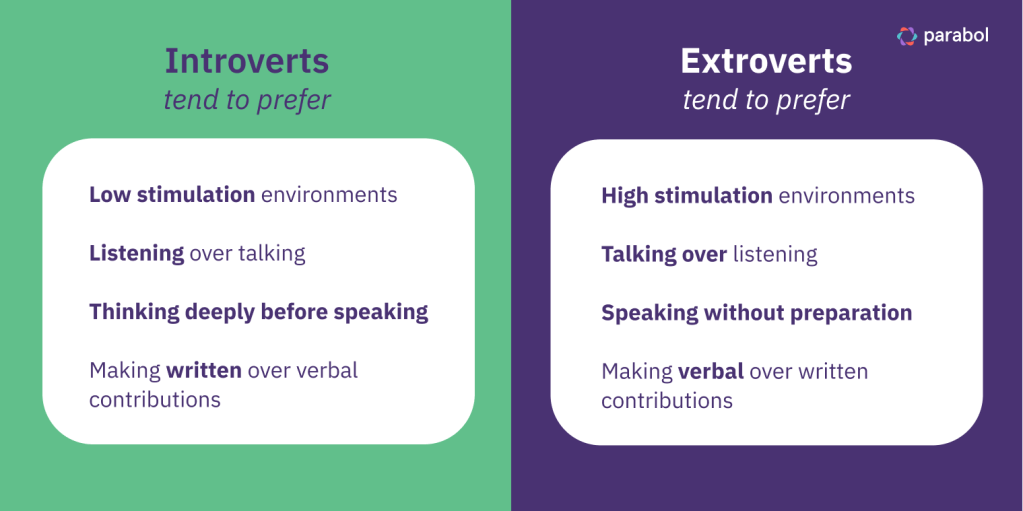
But there are also a few misconceptions to clear up.
Introversion is not:
- ❎ Being anti-social – Introverts aren’t by nature anti-social, they just tend to prefer smaller group interactions and a lower level of social stimulation than extroverts
- ❎ Having social anxiety – While it may be hard for introverts to speak up, it’s not synonymous with social anxiety. Introverts can still be assertive and confident.
- ❎ Being shy – Just because an introvert isn’t speaking much, doesn’t mean they are shy. They might be listening intently or processing information they’ve heard.
Now we have a good idea of what introversion is, let’s talk about why getting introverts contributing is so important.
Why an inclusive meeting culture is important
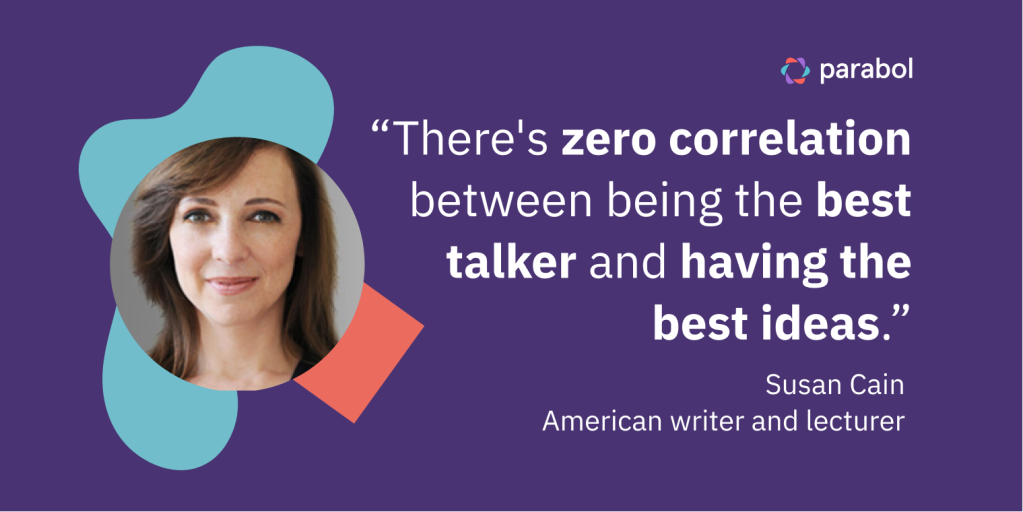
Meetings offer a chance for teams to come together and discuss ideas, collaborate, plan ahead, and unblock each other. But it can be difficult to ensure introverts’ voices are heard.
If you’re facilitating a meeting with a team comprised mostly of introverts, you may know that getting contributions with a regular meeting format may feel… difficult. Often, introverts would rather not be in the meeting at all.
But whether introverts want to be there or not, they have a lot to contribute.
And it turns out that the energy of a traditional meeting, where ideas are ping-ponged, built upon, and decisions are made, favours extroverts.
We’ll get onto how to solve those problems soon (skip ahead here if you like), but first let’s just be clear about the benefits of adapting meetings for introverts and the risks of not getting their opinions.
Designing inclusive meetings helps you to:
- Create a workplace where everyone can add value as their authentic self
- Open up more diverse opinions and ways of thinking
- Ensure everyone is included and has an equal opportunity to participate
The risk of not consciously including introverts are that:
- Introverts feel excluded which can damage morale and lead to people not feeling heard
- Introverts sit with tensions that are difficult to express or only become apparent when the meeting has ended
- You miss out on important ideas introverted team-mates have to contribute.
So how can you switch up your meeting format to help introverts and extroverts alike contribute in a way that suits them?
It sounds like a tall order, but we’ve got plenty of tips here to take off the burden.
How to make meetings more inclusive of introverts
There’s one thing that all teams need to make people feel good contributing in meetings. And it’s not coffee and pastries (although those things certainly helps). It’s psychological safety.
There are many things you can do to build psychological safety (here are some of our pointers), and it is the bedrock of authentic team relations.
Before the meeting
Psychological safety is something your team should build in general, in your day-to-day work together. But there are also specific things you can do before your meeting to help introverts contribute better.
1.👀 Circulate an agenda in advance
This helps introverts prepare in advance for the meeting by familiarising themselves with the topics and creating notes. You can still give people the opportunity to add agenda items during the meeting as they came up, because sometimes you only remember an important thing during a meeting, or something a colleague says triggers an idea for you.
What it sounds like: Hi team, here’s the agenda for our meeting next week. Feel free to add anything else that comes up with you. I wanted to share this in advance so you have time to prepare or think about it.

2.👋 Use 1:1s strategically
Introverts tend to prefer smaller group interactions, so as a facilitator use your 1:1 meetings to have deeper conversations, and if someone has mentioned something interesting during the 1:1 that would be useful for the group, ask permission to raise it during the meeting. This gives introverts validation of their ideas and helps them to contribute in meetings. And research even shows that employees who have regular 1:1 meetings are 3 times more engaged. So having regular 1:1 meetings actually creates a more engaged workforce that is more prone to contributing.
What it sounds like: How did you feel about the discussion we had last week on the task backlog? OR That’s a really interesting point – do you mind if I bring it up in our next team meeting?
3.💬 Discuss meeting preferences openly
Have an open discussion with your team about what works about meetings and what doesn’t. Have some fun by doing a personality test together or playing our Planets in Orbit game or another game to find out each others’ working and meeting preferences. You can even get a feel for your colleagues’ preferences by doing a poll or survey that includes questions such as whether you prefer to know what the plans are for a meeting ahead of time, or whether you prefer thinking over things vs deciding in the moment. This exercise can help you collect the right data to build a meeting culture that works for everyone.
What it sounds like: I want us to try something different today. Let’s play a quick game to talk about how we all fit together as a team.
4. ⌛ Collect input asynchronously
For meetings like retrospectives, post-mortems, or brain-storming meetings that require every team member to reflect on a project or period of work or come up with creative ideas, it’s worth giving people time to add their reflections a few days in advance. People leaning towards the introvert side of the scale tend to ideate when they’re not under pressure. So if you want to get the best ideas out of your team, open your meeting up for asynchronous contributions.
What it sounds like: Our retrospective meeting is scheduled for this Friday. I’ve opened the retrospective board now so you can add reflections as they come to you over the course of the week. I’ll also give us a few minutes at the start of the meeting to add additional thoughts.

5.📜 Create an artifact
Introverts tend to work better when there’s a solid thing to refer back to. And they generally prefer contributing in written form over speaking. Creating an artefact before a meeting to discuss during the meeting gives introverts an anchoring point and the opportunity to make contributions in advance.
What it sounds like: I’ve put together a draft of the new proposal. Please feel free to add comments before our next meeting where it’s on the agenda for us to discuss.
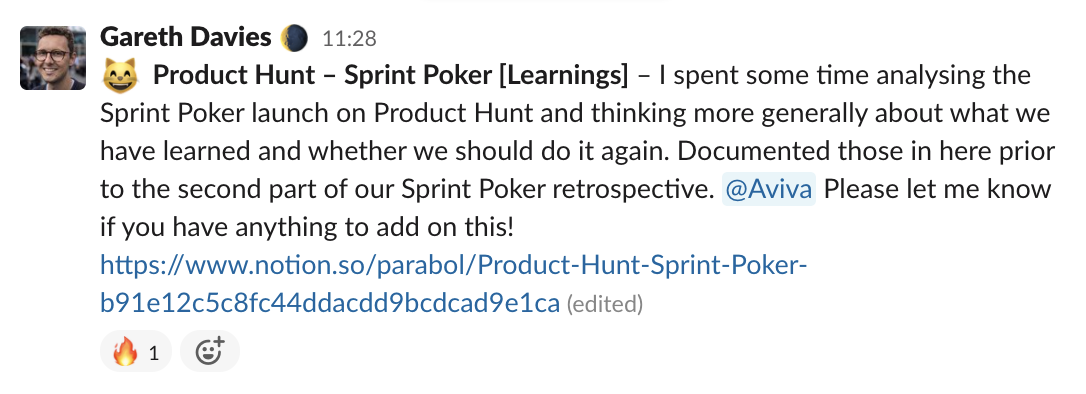
An example of creating a document in advance of a meeting. As an introvert this helps me organise my own thoughts, and helps other introverts by giving something to review in advance of the meeting.
6.🎮 Play games together
As part of your general rhythm of work, schedule some time to play games together. Playing video games has proven to be good for the well-being of introverts and provides an easy way for them to feel more comfortable contributing to the group in general. Try playing a co-op game where the team has to work together to solve problems. Research also shows that co-op games make teams more successful than competitive games!
What it sounds like: I’m setting up some social time once per week for us to hang out and play some games together as a group.
7.🙋♀️ Make a poll
Got a decision to make in your upcoming meeting? Send a poll out in advance. Introverts feel safer contributing when they can also see the lay of the land and how other people are thinking about a topic. But it also helps to kickstart the conversation because you can ask: “Magda, I’m curious why did you decide to select that option?”. Want to prevent anchoring? Keep the poll anonymous until everyone has voted. We use Polly in Slack to run polls. If we want to vote on meeting topics to discuss, we collect ideas in Parabol and give everyone the chance to vote on the issues that matter most to them. Then we discuss the issues with the most votes.
What it sounds like: Before we have our meeting, I want to see what we’re all thinking about the design options for the new website. Can you all participate in this poll? I’ll reveal the results when everyone has voted.

During the meeting
It’s the day of your big meeting. What can you do to make everyone feel comfortable and help them contribute their best ideas as their authentic selves?
The goal isn’t to now create a format that favours introverts. It’s to mix up techniques that help everyone – introverts and extroverts – contribute meaningfully.
Here are our top tips:
8. ☕ Start with an icebreaker
A quick icebreaker question not only helps team members get to know each other, it also gives everyone an equal chance to speak at the start of the meeting. Giving everyone the chance to speak early in the meeting is important because it helps people be present and sets the norms of speaking and listening (not interrupting each other). If you don’t want to run an icebreaker, simply starting the meeting informally with chit chat or another type of icebreaker activity. This can also help more introverted and extroverted people form social connections that make introverts feel comfortable around colleagues.
What it sounds like: If you could describe your personality as a colour, what would it be? And why?
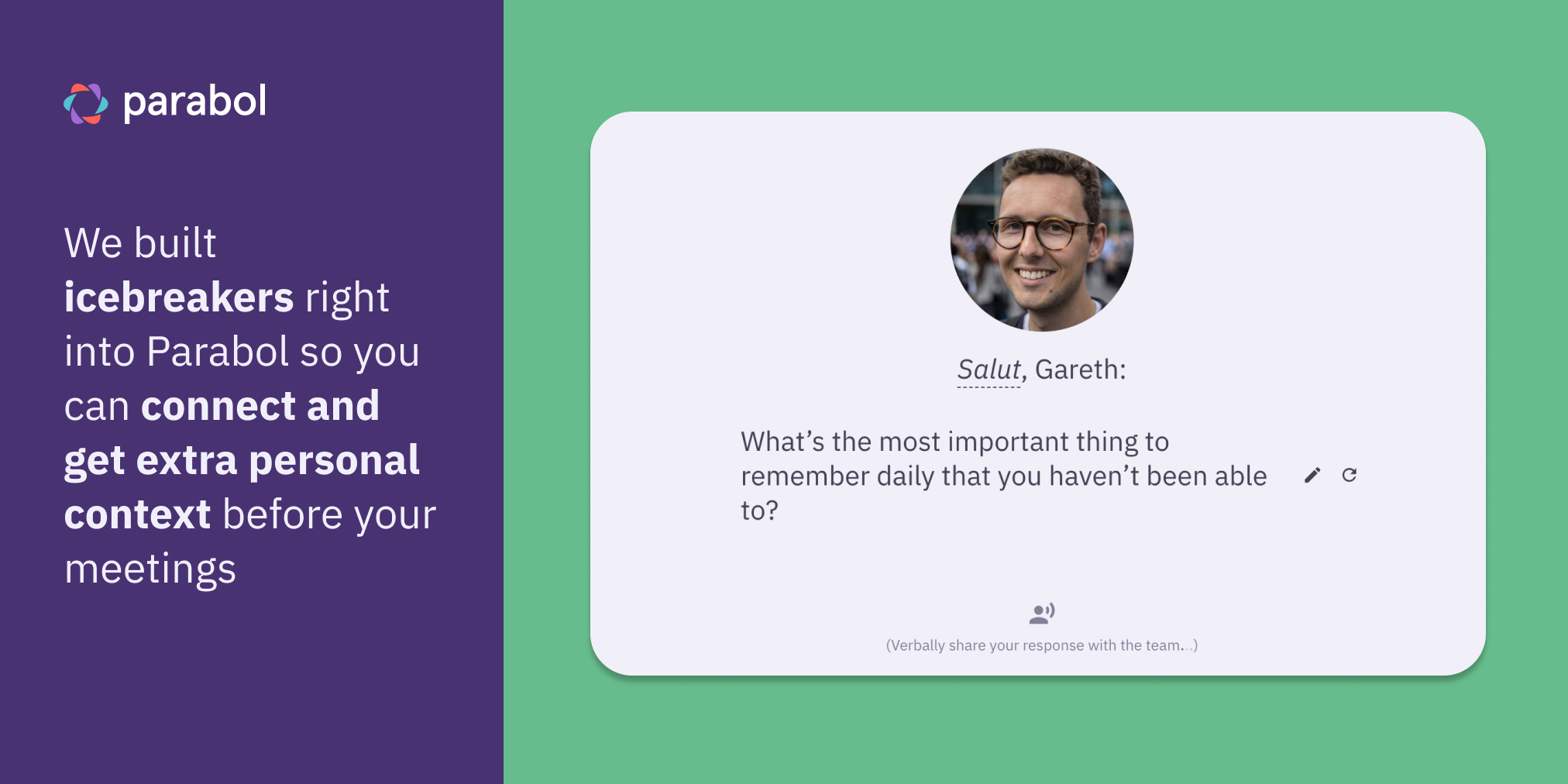
9.❓Pose questions to prompt answers
Ever had that deer in the headlights moment when someone asks you a question that seems so vast you just don’t know how to answer it? Facilitators can help introverts to contribute by asking either/or questions about a topic that let people make a choice, instead of broad questions that require the kind of expansive thinking that introverts sometimes need time to do. Sometimes neither option will satisfy your team member, which prompts a deeper contribution.
What it sounds like: Instead of: What should we do about the new product feature?
Try saying: Would it be easier to push hard and release it this week, or comb through additional bugs and release next week?
10.👍 Reinforce positive contributions
When someone on your team makes a positive contribution to the discussion, thank them for doing so to reinforce the behaviour. However, be mindful of the way you give kudos or thank people, because some folks can feel uncomfortable being called out in public. To avoid an awkward situation make sure you’ve done that important pre-meeting exercise of discussing preferences.
What it sounds like: That’s a really great point. Thanks Elisa for raising it.
11. 🧱 Break into small groups
Contributing to a big group can feel scary. You don’t want to say something stupid and the conversation can move too fast to get your point in. So breaking into small groups to work on a problem, ideate, or document a plan can help introverted people engage more and deliver better quality contributions. Pairing an introverted person with a more extroverted person allows the more extroverted person to report findings back to the group.
What it sounds like: Let’s break into small groups for just 10-15 minutes to work through some potential solutions to this project. We’ll then come back and share what we’ve learned.
12.✍️ Encourage and value written input
Sometimes when a group are deep into a discussion and an introvert has something to contribute, it can be hard to get a word in. Encourage your team to use the chat function of your meeting tool when they have a burning point to make but can’t get it into the conversation. As a facilitator, make sure to treat those written contributions with the same attention you would someone speaking. In Parabol, you can add those comments in the meeting for everyone to see, and toggle whether they are anonymous or not.
What it sounds like: Please everyone add comments in the meeting discussion thread if you have additional things to contribute or if you’d prefer to make your contributions that way.
13.👻 Encourage anonymous contributions
This one might seem a bit strange, but bear with me here. Letting team members contribute reflections or thoughts anonymously helps introverts to contribute without feeling like they’re in the spotlight. It can also generally help to improve psychological safety in a group setting. Anonymous comments and reflections are much easier to do digitally than in person. Something like Parabol’s retrospective tool can help you collect, group, and vote on anonymous meeting input and write anonymous meeting comments.
What it sounds like: Please add your feedback or reflections in Parabol at the start of the meeting. Everything will be anonymous, so feel free to bring up any difficult topics on your mind and we’ll make sure to discuss them.

14. 🙊 Give the option to speak
One thing many introverts hate is being put on the spot and forced to come up with a response to a question. It can trigger stress and panic if your position on something isn’t fully formed. You might feel the pressure that it should be formed and you are expected to come out with something great. But one way to avoid this is to ask a team member if they have anything to contribute on a topic. Set clear expectations in advance that it’s okay to say no or to say “my thoughts on this aren’t clear yet”. Asking team members if they want to add anything is a much better way of asking for contributions from an introvert than simply saying “Jessica, what do you think?”
What it sounds like: I know that some you have also thought a bit about this topic before, do you have anything you want to add on that?
15.🧠 Build on domain expertise
It’s often not easy for introverts to form fast ideas on new topics in a meeting. But if you ask an introvert questions in their domain of expertise, or about parts of a product or process they are familiar with, it’s much easier to get contributions.
What it sounds like: Geoff, you’re our DevOps expert around here. Do you think there’s anything else we need to consider for the migration?
16.🔮 Have a round of clarifying questions
Introverts are often data gatherers. We want to have as much information to hand before taking a position (and we tend to be more naturally skeptical too). So encourage your team members to ask clarifying questions on a topic or agenda item if they need to. Sometimes introverts aren’t contributing because they simply need more information before they can react or make a meaningful comment.
What it sounds like: Does anyone have any clarifying questions on any of this before we move ahead to reactions?
17.👔 Give everyone a role
Roles give everyone something to do in a meeting and giving people different parts of the facilitator role. For example, one person can be responsible for the icebreaker, one person responsible for time-boxing discussions, one person for calling out interrupters, one person for note-taking. Not only does this keep everyone engaged, but it helps teams better adopt and abide by their own meeting culture.
What it sounds like: Nadia will do the icebreaker this week, Liam, can you be our note-taker? And Daria, can you take meeting notes?
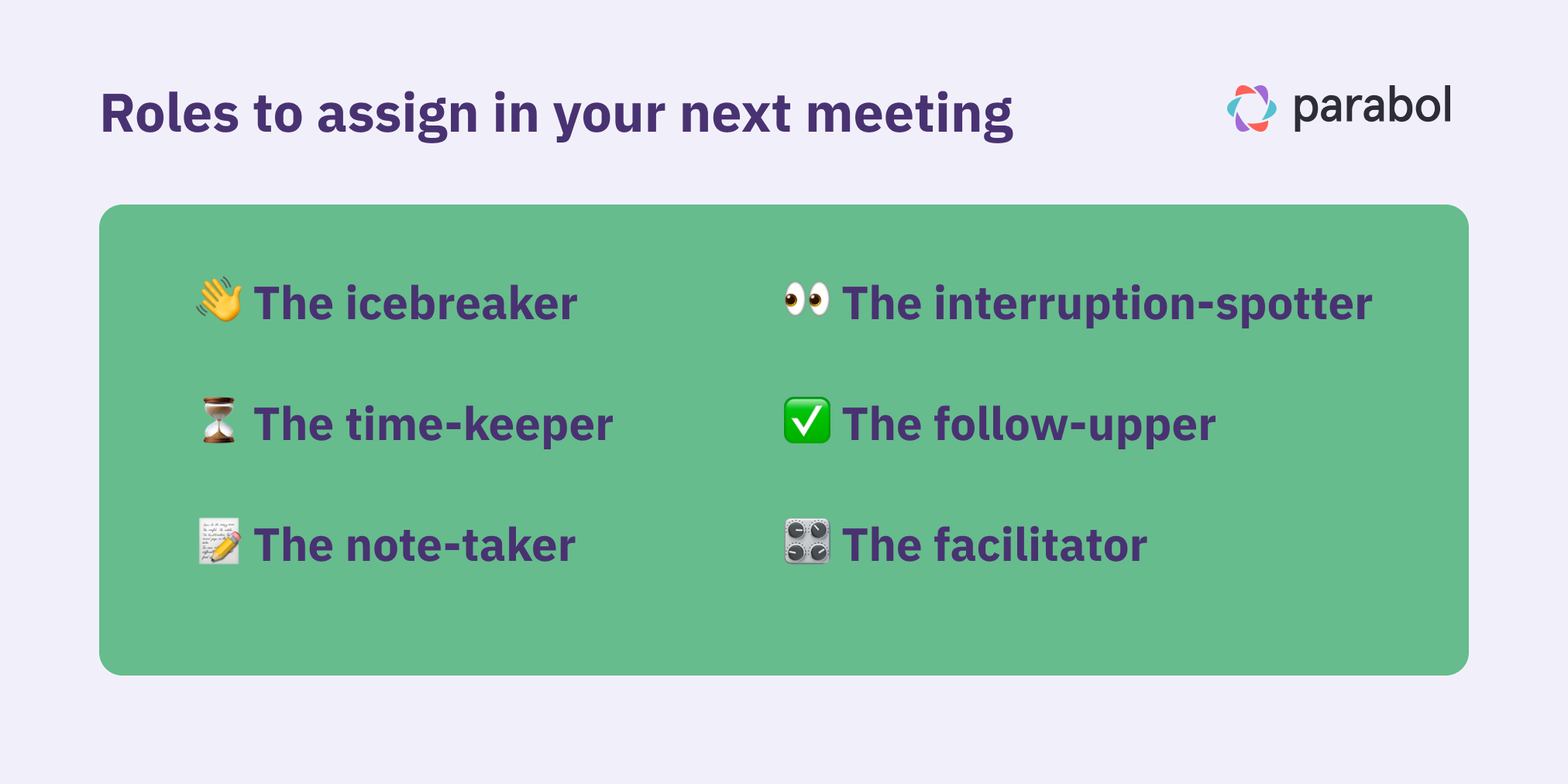
18.👂 Nurture a supportive listening environment
There’s nothing worse than a meeting where everyone is dying to say the next thing and have their voice heard. Nobody’s listening to anyone else and is more concerned with saying their own piece. For introverts who might have to build themselves up to make a contribution to a meeting, being cut off by a louder voice can damage confidence, damage your train of thought, and dissuade you from speaking up again in future. As a facilitator, you want to make sure that when someone is speaking, everyone is listening. You can do this by giving people specific turns to speak and calling out interrupters. Encourage interrupters to make their contribution by writing it in your meeting’s discussion thread or chat section.
What it sounds like: I’d like to hear what Ahmed has to say right now. If you’ve got something pressing to add, would you mind jotting it down in the discussion thread so it’s heard? We’ll come to it after Ahmed has finished.
19. ⏱ Give adequate processing time (3Ps method)
Everyone processes information differently. Introverts tend to do it more slowly. So what feels like an awkward silence to a facilitator might be valuable processing time for introverts. Beth Wonson, founder of Navigating Challenging Dialogue – a leadership consultancy – makes the point that “some people come up with their best contributions after the topic has already changed”. So giving that processing time can build a productive rhythm of listening and processing and thinking before speaking. You can also try the 3Ps method (Participate, Pause, or Pass) by giving everyone 60 seconds to speak each time it’s their turn to speak. Each person uses their 60 seconds as they choose, to participate, pause, or pass. Pausing can force the whole group to take that valuable processing time. And you can still participate or pass after choosing to pause.
What it sounds like: Let’s stop for a minute and just process that information together before continuing the discussion together.
After the meeting
The meeting shouldn’t end the moment you all leave the video call or conference room. There are a few savvy things you can do after your meeting to maximise inclusion and get the best out of your team. Here are our recommendations:
20. ️♻️ Collect feedback
Run an online retrospective on your meetings to look back at what you learned, liked, lacked and longed for. Regularly taking the temperature on your meetings will give you a clear way to process any tensions at risk of being buried so you can form up a better and more inclusive meeting culture.
What it sounds like: Let’s reflect on our recent meetings and how they are going. Is there anything we need to change? What could we do better? How could we better reach our goals?
21.🚪 Keep the meeting open
Don’t just end the meeting when your allotted time is up. Folks on the introverted side of the scale often need time to process and ideate to come up with their best ideas. So keep the meeting open a day or so after it’s taken place. This could be an online meeting in a tool like Parabol, or simply a discussion you were having. Create a thread in Slack/Teams or a shared place in Notion or Google Docs where post-meeting ideas and thoughts can be logged.
What it sounds like: I’ve set up a thread in Slack. If there are any additional thoughts coming out of the meeting over the next couple of days please document them here.
22. ✅ Make decisions after not during meetings
For the same reasons you might want to keep the meeting open, it’s a good practice not to make decisions in the scrum of a video call. Instead, consider setting up a decision-making framework for your organisation that gives introverts and extroverts alike the chance to contribute in a more measured and thoughtful way after discussing issues in a meeting. Parabol’s decision-making process starts with drafting a proposal (this should be the outcome from your meeting), then an unlimited round of clarifying questions, reactions, and then any objections.
What it sounds like: After our meeting, I’ve written up a proposal for the decision on our new holiday policy. Does anyone have any clarifying questions? After questions we can move onto reactions and objections.

Parabol uses a consent-based governance workflow in Slack. It all starts with a written proposal before going through clarifying questions, reactions and objections. Important decisions are never set in stone during meetings.
23.❤️ Try a Heard, Seen, Respected activity
If you’re serious about making your meetings more inclusive, try using the Heard, Seen, Respected activity from Liberating Structures to get the whole group reflecting more deeply on meetings. This gives each participant the option to tell a short story about a time in the meeting, or in general, when they felt heard, seen, or respected. This knowledge helps every team-mate understand better how their colleagues like to be treated and how to make them feel… well, heard, seen, and respected.
What it sounds like: I felt heard when everyone actually took the time to listen to my point about the new product launch. Sometimes it’s difficult for me to take up the air-time, but I like that everyone held off from interrupting me and actually heard me out.
Creating a new meeting culture might feel weird at first
Creating a meeting culture that suits everyone on your team is hard. Humans are complex and it’s often impossible to satisfy everyone completely.
That’s why designing your meetings to be inclusive is all about compromise.
So extroverts will sometimes have to quieten down and engage in activities that help introverts contribute better, such as group work or creating artifacts.
By the same token, introverts should make an effort to understand extroverts and engage in back and forth conversations.
It’s all about finding a mixture of techniques that help you best expose the collective intelligence of your team – not just individual egos.
We’ve already discussed how introversion is a spectrum, and that the existing binary is kind of false.
But introvert-leaning people make up a huge portion of the population, so unless we adapt meetings to help them thrive, our workplaces cannot be inclusive and we miss out on all they have to offer.




